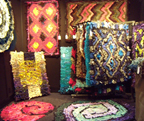When people visit my studio during the annual Studio Tour, I tend to hear comments like, “Where do you get all your ideas?” When I visit other artists’ studios, I ask, “How do you store all your stuff?” I imagine that painters have it “easy,” all they have to worry about is a few tubes of paint and they don’t take up much space. (Completed canvases, OTOH, are a whole ‘nother matter.) One welder envied me when I said my dead art rotted away (in the days when I was more actively chainsaw carving). He couldn’t get rid of steel that easily.
I discovered a cute little garden art project last week; a new way to make bird baths and bird feeders out of cold glass available in the yard sale and thrift shop market. Beautiful stuff. And so I’ve been acquiring raw material. It’s a quiet Sunday night and I took out my “parts” and my new tube of glue and was all ready to start assembling, thinking I had everything I needed, but what I have simply doesn’t sing yet. I have enough “parts” for four or five bird feeders, but it turns out I will have to accumulate enough parts for 20 in order to get four or five good ones. And then I’ll sell three and keep everything on hand for another four years.
At least glass doesn’t rot, and if I get some plastic storage bins, I can keep the parts in the basement.
This is not the case for the raw fabric I use in my rugs, which is spilling out from under my work table and threatening to overtake my sewing room if I don’t get a few hours of slicing in soon. Several rugs ago, I got a little low on “slice,” and I can tell that for a brief interlude, the depth of color in the rugs that I pulled during that period was less than I really like.
For some artists, it’s all in the inventory. Debbie New was quoted in KnitKnit saying that “the way you choose to arrange your yarns (stash, aka inventory) exerts some influence on what you choose to make with them.” (p. 147) To me, that is the most important sentence in the book. I need stash on hand; I need variety, I need to be able to choose among a number of options and have the best one on hand. Raw material for my rugs is not found in any store, and living where I do, one plans trips to town carefully, anyway. The same is true when I make furniture, or carve. I need to have the “stuff” here, available, to hand. The material itself makes some of the decisions.
My art inventory is bursting out of the seams of this house. I contemplate a storage shed, or perhaps moving a small (12×60?) mobile home into the backyard. For textiles, it would need to be heated space, I’m afraid, and then the county has an opinion about what I can do.
Some art forms cost approximately $100 to get into, and others start at $1000 (welding), and it appears that my glass birdbath idea is at least in the $100 range. I’m in it for $45 at the moment, so I shouldn’t expect too much.
Stay tuned. This is a tiny salvo in a much larger problem; idea management is just as much an issue. Maybe I’ll figure it out one of these days, and until then, I can only hope I don’t die suddenly. The stuff piled up really is raw material that will become art in the foreseeable future, as opposed to useless and tragic accumulation and hoarding, but it’s possible that not everyone would understand the difference.

